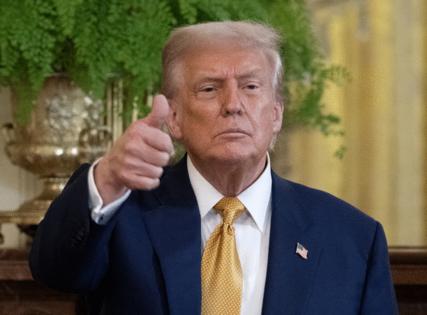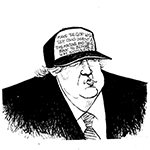EU, US reach deal to avoid trump tariff hike before deadline
Published in News & Features
The U.S. and European Union agreed to a deal that will see the bloc face 15% tariffs on most of its exports, including automobiles, staving off a trade war that could have delivered a hammer blow to the global economy.
The pact comes less than a week before a Friday deadline for President Donald Trump’s higher tariffs to take effect. The president in May threatened to impose a 50% duty on nearly all EU goods, adding pressure that accelerated negotiations, before lowering that to 30%.
Trump announced the deal Sunday after a meeting with European Commission President Ursula von der Leyen, though the full details of the pact were not immediately available.
The U.S. president said the charge would cover “automobiles and everything else.” The European leader said the rate would be “all inclusive,” though Trump said later it did not include pharmaceuticals and metals. Steel and aluminum “stays the way it is,” the U.S. president added, and drugs are “unrelated to this deal.”
“I think that basically concludes the deal,” Trump told reporters at his golf club in Turnberry, Scotland. “It’s the biggest of all the deals.”
Von der Leyen said the agreement “will bring stability” and “it will bring predictability.”
The EU agreed to purchase $750 billion in American energy products, invest $600 billion in the U.S. on top of existing expenditures, open up countries’ markets to trade with the U.S. at zero tariffs and purchase “vast amounts” of military equipment, Trump said.
Ahead of the meeting, the EU was expecting a 15% charge on its imports to also apply to most pharmaceuticals. The products had been one of the negotiation’s main sticking points.
For months, Trump has threatened most of the world with high tariffs with the goal of shrinking U.S. trade deficits. But the prospect of those duties — and Trump’s unpredictable nature — put world capitals on edge.
The transatlantic pact removes a major risk for markets and the global economy — a trade war involving $1.7 trillion worth of cross-border commerce — even though it means European shipments to the U.S. are getting hit with a higher tax at the border.
The goals, Trump said, were more production in the U.S. and wider access for American exporters to the European market. Von der Leyen acknowledged part of the drive behind the talks was a rebalancing of trade, but cast it as beneficial for both sides.
“The starting point was an imbalance,” von der Leyen said. “We wanted to rebalance the trade we made, and we wanted to do it in a way that trade goes on between the two of us across the Atlantic, because the two biggest economies should have a good trade flow.”
The announcement capped off months of often tense shuttle diplomacy between Brussels and Washington. The two sides appeared close to a deal earlier this month when Trump made his 30% threat.
The EU had prepared to put levies on about €100 billion ($117 billion) — about a third of American exports to the bloc — if a deal wasn’t reached and Trump followed through on his warning.
U.S. and European negotiators had been zeroing in on an agreement this past week, and the decision for von der Leyen to meet Trump at his signature golf property brought the standoff to a dramatic conclusion.
Officials had discussed terms for a quota system for steel and aluminum imports, which would face a lower import tax below a certain threshold and would be charged the regular 50% rate above it. The EU had also been seeking quotas and a cap on future industry-specific tariffs, but it’s unclear if the initial agreement will shield the bloc from potential levies that have yet to be implemented.
U.S. Commerce Secretary Howard Lutnick said a decision on semiconductors, which, like drugs are subject to an ongoing investigation that opens the door to separate tariffs, would be dealt with in roughly “two weeks” when that probe ends.
The EU for weeks indicated a willingness to accept an unbalanced pact involving a reduced rate of around 15%, while seeking relief levies on industries critical to the European economy. The U.S. president has also imposed 25% duties on cars and double that rate on steel and aluminum, as well as copper.
Several exporters in Asia, including Indonesia, the Philippines and Japan, have negotiated reciprocal rates between 15% to 20%, and the EU saw Japan’s deal for 15% on autos as a breakthrough worth seeking as well. Washington’s talks also continue with Switzerland, South Korea and Taiwan.
Trump said he is “looking at deals with three or four other countries” but “for the most part” others with smaller economies or less significant trading relationships with the U.S. would receive letters simply setting tariff rates.
Trump announced a range of tariffs on almost all U.S. trading partners in April, declaring his intent to revive domestic manufacturing, help pay for a massive tax cut and address economic imbalances he has said are detrimental to U.S. workers. He put them on pause a week later due when investors panicked.
Trump’s decades-old complaints about the global trading system heap particularly sharp scorn on the EU, which he has accused of being formed to “screw” the U.S. The bloc was established in the years following World War II in order to establish economic stability on the continent.
The president has lashed out at non-tariff barriers for American companies to do business across the 27-nation bloc. Those include the EU’s value-added tax, levies on digital services, and safety and environmental regulations.
Weeks of negotiations tested the EU’s willingness to digest what is seen as an asymmetrical outcome, a senior EU diplomat said, but one that offers an opportunity to continue the talks without escalating further.
_____
—With assistance from Skylar Woodhouse.
_____
©2025 Bloomberg L.P. Visit bloomberg.com. Distributed by Tribune Content Agency, LLC.







Comments